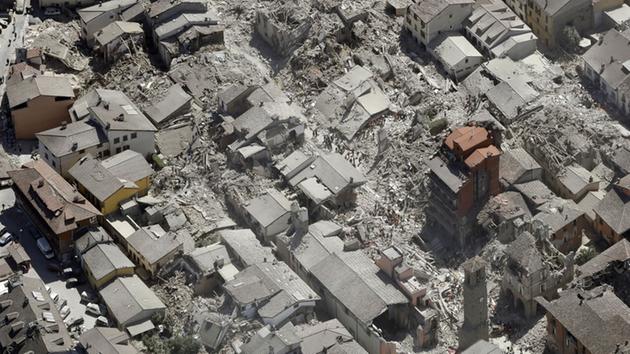
Italian authorities say that the death toll from Wednesday's earthquake in the central part of the country has risen to 247. (AP Photo/Gregorio Borgia)
Updated 1 hr 52 mins ago
ROME -- Rescue crews raced against time Thursday looking for survivors from the earthquake that leveled three towns in central Italy, but the death toll rose to 247 and Italy once again anguished over trying to secure its medieval communities built on seismic lands.
Dawn broke over the rolling hills of central Lazio and Le Marche regions after a night of uninterrupted search efforts. Aided by sniffer dogs and audio equipment, firefighters and rescue crews using their bare hands pulled chunks of cement, rock and metal apart from mounds of rubble where homes once stood searching for signs of life.
PHOTOS: Deadly earthquake in Italy
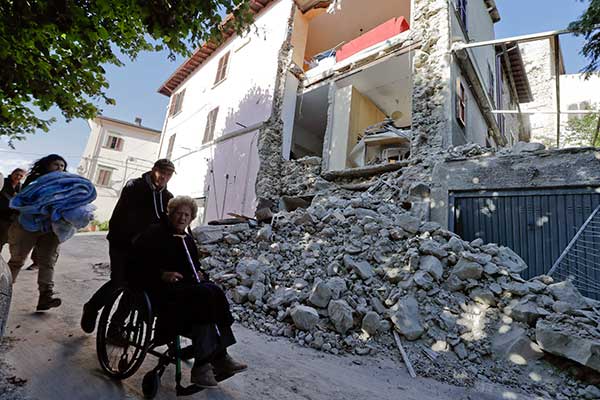

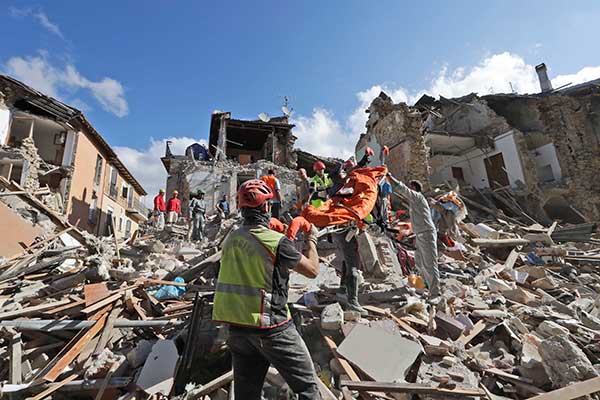


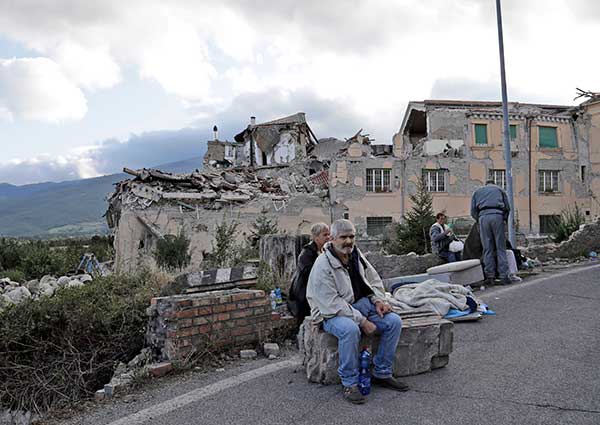

A woman on a wheelchair is pushed past a partially collapsed building is seen in the background following an earthquake, in Accumoli. (Andrew Medichini/AP Photo)
One area of focus was the Hotel Roma in Amatrice, famous for the Amatriciana bacon and tomato pasta sauce that brings food lovers to this medieval hilltop town each August for its food festival.
Amatrice's mayor had initially said 70 guests were in the crumbled hotel ahead of this weekend's festival, but rescue workers later halved that estimate after the owner said most guests managed to escape.
Firefighters' spokesman Luca Cari said that one body had been pulled out of the hotel rubble just before dawn but that the search continued there and elsewhere, even as 460 aftershocks rattled the area after the magnitude 6 temblor struck at 3:36 a.m. on Wednesday.
"We're still in a phase that allows us to hope we'll find people alive," Cari said, noting that in the 2009 earthquake in nearby L'Aquila a survivor was pulled out after 72 hours.
Worst affected by the quake were the tiny towns of Amatrice and Accumoli near Rieti, 100 kilometers (60 miles) northeast of Rome, and Pescara del Tronto, 25 kilometers (15 miles) further east.
Italy's civil protection agency reported the death toll had risen to 247 early Thursday with at least 264 others hospitalized. Most of the dead - 190 - were in Amatrice and Accumuli and their nearby hamlets.
"From here everyone survived," said Sister Mariana, one of three nuns and an elderly woman who survived the quake that pancaked half of her Amatrice convent.
"They saved each other, they took their hands even while it was falling apart, and they ran, and they survived."
She said that others from another part of the convent apparently didn't make it: Three other nuns and four elderly women.
The civil protection agency set up tent cities around the affected towns to accommodate the homeless, 1,200 of whom took advantage of the offer to spend the night, civil protection officials said Thursday. In Amatrice, some 50 elderly and children spent the night inside a local sports facility.
"It's not easy for them," said civil protection volunteer Tiziano De Carolis, helping to care for about 350 homeless in Amatrice.
"They have lost everything, the work of an entire life, like those who have a business, a shop, a pharmacy, a grocery store and from one day to another they discovered everything they had was destroyed."
As the search effort continued, the soul-searching began once again as Italy confronted the effects of having the highest seismic hazard in Western Europe, some of its most picturesque medieval villages, and anti-seismic building codes that aren't applied to old buildings and often aren't respected when new ones are built.
"In a country where in the past 40 years there have been at least eight devastating earthquakes ... the only lesson we have learned is to save lives after the fact," columnist Sergio Rizzo wrote in Thursday's Corriere della Sera. "We are far behind in the other lessons."
Experts estimate that 70 percent of Italy's buildings aren't built to anti-seismic standards. After every major quake, proposals are made to improve, but they often languish in Italy's thick bureaucracy, funding shortages and the huge scope of trying to secure thousands of ancient towns and newer structures built before codes were passed or after the codes were in effect but in violation of them.
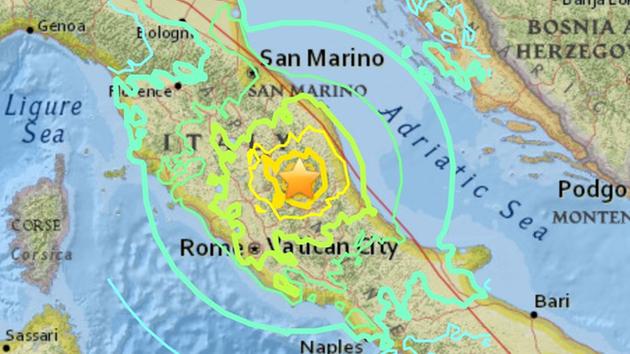
This map shows the epicenter of the 6.1 magnitude earthquake that rocked central Italy. (USGS)
In recent quakes, some of these more modern buildings have been the deadliest: the university dormitory that collapsed in the 2009 L'Aquila quake, killing 11 students; the elementary school that crumbled in San Giuliano di Puglia in 2002, killing 26 children - the town's entire first-grade class. In some cases, the anti-seismic building standards have been part of the problem, including using reinforced cement for roofs that are then too heavy for weak walls when quakes strike.
Premier Matteo Renzi, visiting the quake-affected zone Wednesday, promised to rebuild "and guarantee a reconstruction that will allow residents to live in these communities, to relaunch these beautiful towns that have a wonderful past that will never end."
While the government is already looking ahead to reconstruction, rescue workers on the ground still had days and weeks of work ahead of them. In hard-hit Pescara del Tronto, firefighter Franco Mantovan said early Thursday that crews knew of three residents still under the rubble, but in a hard-to-reach area.
In the evening there, about 17 hours after the quake struck, firefighters pulled a 10-year-old girl alive from a crumbled home.
"You can hear something under here. Quiet, quiet," one rescue worker said, before soon urging her on: "Come on, Giulia, come on, Giulia."
Cheers broke out when she was pulled out.
But there were wails when bodies emerged.
"Unfortunately, 90 percent we pull out are dead, but some make it, that's why we are here," said Christian Bianchetti, a volunteer from Rieti who was working in devastated Amatrice.
=================================

At least 120 people have been killed after an earthquake hit central Italy. Rescue crews are in a desperate race to dig survivors out of the rubble. (AP)
Updated 1 hr 1 min ago
ROME -- Rescue crews using bulldozers and their bare hands raced to dig out survivors from a strong earthquake that reduced three central Italian towns to rubble Wednesday. The death toll stood at 120, but the number of dead and missing was uncertain given the huge number of vacationers in the area for summer's final days.
Residents wakened before dawn by the temblor emerged from their crumbled homes to find what they described as apocalyptic scenes "like Dante's Inferno," with entire blocks of buildings turned into piles of sand and rock, thick dust choking the air and a putrid smell of gas.
PHOTOS: Deadly earthquake in Italy







A woman on a wheelchair is pushed past a partially collapsed building is seen in the background following an earthquake, in Accumoli. (Andrew Medichini/AP Photo)
"The town isn't here anymore," said Sergio Pirozzi, the mayor of the hardest-hit town, Amatrice. "I believe the toll will rise."
The magnitude 6 quake struck at 3:36 a.m. and was felt across a broad swath of central Italy, including Rome, where residents woke to a long swaying followed by aftershocks. The temblor shook the Lazio region and Umbria and Le Marche on the Adriatic coast.
Premier Matteo Renzi visited the zone Wednesday, greeted rescue teams and survivors and said the casualty toll stood at 120 dead and was likely to rise. Another at least 368 were injured. He promised the quake-prone area that "No family, no city, no hamlet will be left behind."
Hardest hit were the tiny towns of Amatrice and Accumoli near Rieti, some 100 kilometers (62 miles) northeast of Rome, and Pescara del Tronto, some 25 kilometers further east. Italy's civil protection agency, which was coordinating the rescue and care for survivors, said dozens were injured and thousands in need of temporary housing, though it stressed the numbers were fluid.
Italy's health minister, Beatrice Lorenzin, visiting the devastated area, said many of the victims were children: The quake zone is a popular spot for Romans with second homes, and the population swells in August when most Italians take their summer holiday before school resumes.
The medieval center of Amatrice was devastated, with the hardest-hit half of the city cut off by rescue crews digging by hand to get to trapped residents. The birthplace of the famed spaghetti all'amatriciana bacon and tomato sauce, it is made up of 69 hamlets that teams from around Italy were working to reach with sniffer dogs, earth movers and other heavy equipment.
Rocks and metal tumbled onto the streets of the city center and dazed residents huddled in piazzas as more than 200 aftershocks jolted the region into the early morning hours, some as strong as magnitude 5.1.
"The whole ceiling fell but did not hit me," marveled resident Maria Gianni. "I just managed to put a pillow on my head and I wasn't hit, luckily, just slightly injured my leg."
Another woman, sitting in front of her destroyed home with a blanket over her shoulders, said she didn't know what had become of her loved ones.
"It was one of the most beautiful towns of Italy and now there's nothing left," she said, too distraught to give her name. "I don't know what we'll do."
"We need chain saws, shears to cut iron bars and jacks to remove beams. Everything, we need everything," civil protection worker Andrea Gentili told The Associated Press in the early hours of the recovery. Italy's national blood drive association appealed for donations to Rieti's hospital.
Despite a massive rescue and relief effort - with army, Alpine crews, carabineri, firefighters, Red Cross crews and volunteers, it wasn't enough: A few miles (kilometers) north of Amatrice, in Illica, residents complained that rescue workers were slow to arrive and that loved ones were trapped.
"We are waiting for the military," said resident Alessandra Cappellanti. "There is a base in Ascoli, one in Rieti, and in L'Aquila. And we have not seen a single soldier. We pay! It's disgusting!"
Agostino Severo, a Rome resident visiting Illica, said workers eventually arrived after an hour or so. "We came out to the piazza, and it looked like Dante's Inferno," he said. "People crying for help, help."
The magnitude 6 quake's epicenter was located near Accumoli and Arquata del Tronto and had a shallow depth of just four kilometers, Italy's geological institute said. Generally, shallow earthquakes pack a bigger punch and tend to be more damaging than deeper quakes.
"The Apennine mountains in central Italy have the highest seismic hazard in Western Europe and earthquakes of this magnitude are common," noted Dr Richard Walters, a lecturer in Earth sciences at Durham University in Britain.

This map shows the epicenter of the 6.1 magnitude earthquake that rocked central Italy. (USGS)
The head of Italy's civil protection service, Fabrizio Curcio, noted that the region is popular with Romans escaping the heat of the capital to their country houses, swelling the population during the summer months. This weekend, Amatrice was due to celebrate its annual festival honoring its native pasta dish, possibly adding to the number of people in town.
The devastation harked back to the 2009 quake that killed more than 300 people in and around L'Aquila, about 90 kilometers (55 miles) south of the latest quake. The town, which still hasn't fully recovered, sent emergency teams Wednesday to help with the rescue and set up tent camps for residents unwilling to stay indoors because of aftershocks.
"I don't know what to say. We are living this immense tragedy," said a tearful Rev. Savino D'Amelio, a parish priest in Amatrice. "We are only hoping there will be the least number of victims possible and that we all have the courage to move on."
Another hard-hit town was Pescara del Tronto, in the Le Marche region, where the main road was covered in debris.
Residents were digging their neighbors out by hand since emergency crews hadn't yet arrived in force. Aerial photos taken by regional firefighters showed the town essentially flattened and under a thick gray coat of dust; Italy requested EU satellite images of the whole area to get the scope of the damage.
"There are broken liquor bottles all over the place," said Gino Petrucci, owner of a bar in nearby Arquata Del Tronto where he was beginning the long cleanup.
One rescue was particularly delicate as a ranger in Capodacqua, in the Marche province of Ascoli Piceno, diplomatically tried to keep an 80-year-old woman calm as she begged to get to a toilet, even though she was trapped in the rubble.
"Listen, I know it's not nice to say but if you need to pee you just do it," he said. "Now I move away a little bit and you do pee, please."
The mayor of Accumoli, Stefano Petrucci, said a family of four had died there, one of the few young families who had decided to stay in the area. He wept as he noted that the tiny hamlet of 700 swells to 2,000 in the summer months, and that he feared for the future of the town.
"I hope they don't forget us," he told Sky TG24.
A 1997 quake killed a dozen people in central Italy and severely damaged one of the jewels of Umbria, the Basilica of St. Francis in Assisi, filled with Giotto frescoes. The Franciscan friars who are the custodians of the basilica reported no immediate damage from Wednesday's temblor.
Pope Francis skipped his traditional catechism for his Wednesday general audience and instead invited the thousands of pilgrims in St. Peter's Square to recite the rosary with him. He also sent a six-man squad from the Vatican's fire department to help with the rescue.
=====================






Diana Rocco reporting live (Francesco Rocca/Twitter)
By PAOLO SANTALUCIA and NICOLE WINFIELD
Updated 48 mins ago
AMATRICE, Italy -- A strong earthquake in central Italy reduced three towns to rubble as people slept early Wednesday, with reports that as many as 50 people were killed and hundreds injured as rescue crews raced to dig out survivors.
The toll was likely to rise as crews reached homes in more remote hamlets where the scenes were apocalyptic "like Dante's Inferno," according to one witness.
"The town isn't here anymore," said Sergio Pirozzi, the mayor of Amatrice. "I believe the toll will rise."
PHOTOS: Deadly earthquake in Italy







A woman on a wheelchair is pushed past a partially collapsed building is seen in the background following an earthquake, in Accumoli. (Andrew Medichini/AP Photo)
The magnitude 6 quake struck at 3:36 a.m. (0136 GMT) and was felt across a broad swath of central Italy, including Rome, where residents felt a long swaying followed by aftershocks. The temblor shook the Lazio region and Umbria and Le Marche on the Adriatic coast.
Premier Matteo Renzi planned to head to the zone later Wednesday and promised: "No family, no city, no hamlet will be left behind."
The hardest-hit towns were Amatrice and Accumoli near Rieti, some 100 kilometers (80 miles) northeast of Rome, and Pescara del Tronto some 25 kilometers further east. Italy's civil protection agency said the preliminary toll was 38 dead, several hundred injured and thousands in need of temporary housing, though it stressed the numbers were fluid.
The ANSA news agency said 35 of the dead were in Amatrice alone, with another 17 dead in the province of Ascoli Piceno, which includes Pescara del Tronto, for a reported total topping 50.
The State Department is urging Americans in Italy to contact friends and family:
The center of Amatrice was devastated, with entire buildings razed and the air thick with dust and smelling strongly of gas. Amatrice, birthplace of the famed spaghetti all'amatriciana bacon-tomato pasta sauce, is made up of 69 hamlets that rescue teams were working to reach.
Rocks and metal tumbled onto the streets of the city center and dazed residents huddled in piazzas as more than 40 aftershocks jolted the region into the early morning hours, some as strong as 5.1.
"The whole ceiling fell but did not hit me," marveled resident Maria Gianni. "I just managed to put a pillow on my head and I wasn't hit luckily, just slightly injured my leg."
Another woman, sitting in front of her destroyed home with a blanket over her shoulders, said she didn't know what had become of her loved ones.
"It was one of the most beautiful towns of Italy and now there's nothing left," she said, too distraught to give her name. "I don't know what we'll do."
As daylight dawned, residents, civil protection workers and even priests began digging out with shovels, bulldozers and their bare hands, trying to reach survivors. There was relief as a woman was pulled out alive from one building, followed by a dog.
"We need chain saws, shears to cut iron bars, and jacks to remove beams: everything, we need everything," civil protection worker Andrea Gentili told The Associated Press. Italy's national blood drive association appealed for donations to Rieti's hospital.
But just a few kilometers to the north, in Illica, the response was slower as residents anxiously waited for loved ones to be extracted from the rubble.
"We came out to the piazza, and it looked like Dante's Inferno," said Agostino Severo, a Rome resident visiting Illica. "People crying for help, help. Rescue workers arrived after one hour... one and a half hours."
The devastation harked back to the 2009 quake that killed more than 300 people in and around L'Aquila, about 90 kilometers (55 miles) south of the latest quake. The town sent emergency teams Wednesday to help with the rescue.
"I don't know what to say. We are living this immense tragedy," said a tearful Rev. Savino D'Amelio, a parish priest in Amatrice. "We are only hoping there will be the least number of victims possible and that we all have the courage to move on."
Another hard-hit town was Pescara del Tronto, in the Le Marche region, where the main road was covered in debris. The ANSA news agency reported 10 dead there without citing the source, but there was no confirmation.
Residents were digging their neighbors out by hand since emergency crews hadn't yet arrived in force. Photos taken from the air by regional firefighters showed the town essentially flattened; Italy requested EU satellite images of the whole area to get the scope of the damage.
"There are broken liquor bottles all over the place," lamented Gino Petrucci, owner of a bar in nearby Arquata Del Tronto where he was beginning the long cleanup.
The Italian geological service put the magnitude at 6.0; the U.S. Geological Survey reported 6.2 with the epicenter at Norcia, about 170 kilometers (105 miles) northeast of Rome, and with a relatively shallow depth of 10 kilometers (6 miles).
"Quakes with this magnitude at this depth in our territory in general create building collapses, which can result in deaths," said the head of Italy's civil protection service, Fabrizio Curcio. He added that the region is popular with tourists escaping the heat of Rome, with more residents than at other times of the year, and that a single building collapse could raise the toll significantly.
The mayor of Accumoli, Stefano Petrucci, said six people had died there, including a family of four, and two others. He wept as he noted that the tiny hamlet of 700 swells to 2,000 in the summer months, and that he feared for the future of the town.
"I hope they don't forget us," he told Sky TG24.
In Amatrice, the Rev. Fabio Gammarota, priest of a nearby parish, said he had blessed seven bodies extracted so far. "One was a friend of mine," he said.
The mayor, Pirozzi, estimated dozens of residents were buried under collapsed buildings and that heavy equipment was needed to clear streets clogged with debris.
A 1997 quake killed a dozen people in central Italy and severely damaged one of the jewels of Umbria, the Basilica of St. Francis in Assisi, filled with Giotto frescoes. The Franciscan friars who are the custodians of the basilica reported no immediate damage from Wednesday's temblor.
Pope Francis skipped his traditional catechism for his Wednesday general audience and instead invited pilgrims in St. Peter's Square to recite the rosary with him.
Valentina Onori in Amatrice and Fulvio Paolucci in Illica contributed to this report.
======================